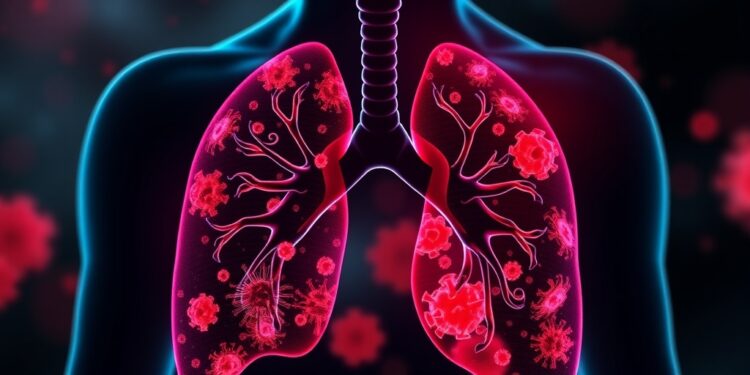The COVID-19 pandemic, caused by the novel virus SARS-CoV-2, has illuminated the vulnerabilities of various health demographics, particularly patients with pre-existing conditions. Among the myriad of affected groups, those suffering from interstitial lung disease (ILD) have stood out. Sarcoidosis, a specific type of ILD, has been highlighted in recent discussions concerning its relationship with COVID-19, raising essential questions about susceptibility, morbidity, and mortality rates associated with the virus. Sarcoidosis is characterized by abnormal immune responses that result in the formation of granulomas, leading to diminished lung function, which may further complicate the clinical outcomes for patients upon contracting COVID-19.
Several studies to date have attempted to unravel the complicated dynamics between COVID-19 and sarcoidosis, yet findings have been inconsistent. Some research has suggested that patients with sarcoidosis might face a heightened risk for severe manifestations of the virus, while others have produced conflicting results, empowering a debate among scientists and medical professionals. Understanding the intricate relationship between these two health conditions is vital, especially as the pandemic continues to evolve and new variants emerge.
A recent meta-analysis sheds light on this critical intersection of health science by compiling data across various studies to clarify the risks faced by sarcoidosis patients infected with SARS-CoV-2. In reviewing existing literature, researchers sought to establish clarity around two principal concerns: the increased incidence of COVID-19 among sarcoidosis patients and the severity of their illness once infected. By leveraging statistical methodologies, including risk ratios (RR) and odds ratios (OR), the study aimed to provide empirical evidence that could influence clinical practices and public health policies.
The results from this comprehensive analysis reveal a staggering risk ratio of 5.86 for the incidence of COVID-19 in sarcoidosis patients, suggesting these individuals are significantly more likely to contract the virus compared to their healthy counterparts. This alarming statistic amplifies the pressing need for targeted interventions, including vaccination initiatives, for those struggling with sarcoidosis. Vaccination could serve as a formidable line of defense, potentially mitigating the infection rate among this high-risk population and decreasing overall health complications associated with the disease.
Moreover, the study documented a considerable increase in intensive care unit (ICU) admissions among infected sarcoidosis patients, with an odds ratio of 2.48. This metric highlights the gravity of the situation; not only are sarcoidosis patients more likely to contract COVID-19, but their circumstances also escalate to severe stages with greater frequency than healthier individuals. Such findings underscore the necessity for heightened monitoring and responsive treatment strategies for this vulnerable group, particularly as the healthcare system faces unprecedented pressures.
In terms of mortality, findings from the meta-analysis indicate a concerning trend as well. An odds ratio of 1.95 suggests that sarcoidosis patients have nearly double the likelihood of dying from COVID-19 when compared to those without the condition. The implications of these statistics are profound; they call for urgent public health messaging aimed at encouraging vaccinations and additional preventative measures tailored for patients with chronic lung diseases.
The conclusions drawn from this meta-analysis are clear: sarcoidosis patients represent a significant risk group within the broader COVID-19 pandemic context. Their predisposition to severe outcomes calls for immediate action from health authorities to prioritize education and clinical support specific to this demographic. As researchers continue to investigate other contributing factors—such as age, sex, and comorbidities—understanding the multifaceted nature of sarcoidosis and its interaction with COVID-19 is essential.
Furthermore, the discussion surrounding how systemic inflammation caused by sarcoidosis may interact with viral infections adds a layer of complexity to this situation. The pathophysiological response in sarcoidosis patients often results in compromised respiratory function, raising questions about how these physiological changes may affect their response to viral pathogens like SARS-CoV-2. This intersectionality warrants a more nuanced approach in both clinical settings and research initiatives to better tailor treatments for affected individuals.
As we continue to navigate through the pandemic, increasing our knowledge about specific vulnerabilities posed by certain health conditions remains pivotal. The findings of the meta-analysis should serve as a clarion call for healthcare systems worldwide to enhance their preparedness strategies for similar respiratory challenges. Rigorous control measures, along with prioritization of vaccination for vulnerable groups, should find their way to the forefront of public health agendas.
In conclusion, the results of the meta-analysis compellingly assert that increased awareness, dedicated resources, and proactive measures are crucial for protecting sarcoidosis patients during this ongoing health crisis. There is a pressing need for further research and continuous ongoing education for both patients and healthcare providers to decrease the deleterious impacts of COVID-19 on individuals with compromised respiratory systems. Above all, collaboration between research entities, healthcare providers, and policy-makers will be crucial in safeguarding the lives of those most vulnerable in the face of unprecedented viral threats.
Subject of Research: Not applicable
Article Title: COVID-19 infection and pulmonary sarcoidosis: a systematic review and meta-analysis of morbidity, severity and mortality
News Publication Date: 28-Feb-2025
Web References: DOI link
References: Not provided
Image Credits: Not provided
Keywords: COVID-19, infections, meta-analysis, sarcoidosis




